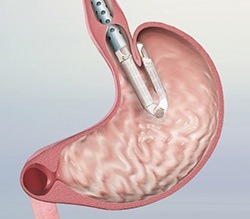Hiatal Hernia Treatment

Surgery
When non-invasive methods fail, surgery is recommended. Laparoscopic fundoplication is considered the standard of care for hiatal hernia.
Procedure
Fundoplication is performed under general anaesthesia. Your surgeon makes five small incision in the upper abdomen and inserts a tubes called a trocars through which the laparoscope and instruments are introduced into the abdomen. CO2 is injected into the abdominal cavity near the belly button to expand the viewing area of the abdomen, providing a clear view to your surgeon and sufficient room to work.
During the procedure, your surgeon first repairs the hiatal hernia, by bringing your stomach down into your abdominal cavity. Sometimes, a type of mesh may be inserted to support and strengthen it. Your surgeon then wraps the upper part of the stomach, the fundus, around the lower oesophagus to create a valve, suturing it in place. This surgery strengthens the muscles and helps prevent stomach acid and food from flowing back into the oesophagus. The laparoscope and other instruments are then removed and the CO2 released. The tiny incisions are closed and covered with small bandages.
Post–operative information
You may feel soreness around the incision areas. Your surgeon will prescribe pain medicine or non-steroidal anti-inflammatory drugs (NSAIDs) for the first few days to keep you comfortable. If the abdomen was distended with gas, you may experience discomfort in the abdomen, chest, or shoulder area for a couple days while the excess gas is being absorbed.
Contact your doctor immediately if you have a fever, chills, increased pain, bleeding or fluid leakage from the incisions, chest pain, shortness of breath, and leg pain or dizziness.
Benefits of this approach
Laparoscopy is much less traumatic to the muscles and soft tissues than the traditional method of surgically opening the abdomen with long incisions (open techniques). In addition, infection risk is less, and patients experience less pain and scarring and a quicker recovery.
Preparation
You may be instructed not to eat or drink anything before the procedure. Your surgeon will give you instructions on the medications you need to avoid. Further investigations may be required prior to surgery to check the level of acid reflux and the movement of the oesophagus.
Outcome
As with any surgery, fundoplication may involve certain risks and complications which include post-operative fever and infection, injury to blood vessels, injury to stomach or oesophagus, swallowing difficulties, gas embolism, adhesions (extensive scar tissue formation can form in the surgical area) and recurrence of the hiatal hernia. Some patients may experience swallowing difficulties, bloating, belching and flatulence which can persist after surgery Rarely you may require further corrective surgery.
Post-op stages of recovery and care plan
After the procedure you will be able to leave the hospital in two or three days. You will be given specific instructions with regard to your diet. You are recommended to eat only soft food such as mashed potatoes or soup during the first two weeks after surgery as hard food can get stuck at the surgery site.
Down-time - lifestyle or off work duration
You can resume your regular activities two weeks after the surgery. However, complete recovery takes around six, during which time, you are advised to avoid hard labour and heavy lifting for three months after surgery. Your surgeon will discuss this with you.
Costs
Any costs involved will be discussed with you prior to your surgery.
Research
Extensive research is being done to find better treatment options for hiatal hernias. Some of the recent studies include:
- Successful laparoscopic management of paraoesophageal hiatal hernia with upside-down intrathoracic stomach: a case report. J Med Case Rep. 2015; 9: 49 doi:10.1186/s13256-015-0519-6;published online 4 Mar 2015. 1
- Hiatal Hernia Repair with or without Oesophageal Lengthening: Is There a Difference? Innovations (Phila). 2013 Sep-Oct; 8(5): 341–347.doi:10.1097/IMI.0000000000000012. 2
- Open versus Laparoscopic Hiatal Hernia Repair. JSLS. 2013 Jan-Mar; 17(1): 23–29.doi:10.4293/108680812X13517013316951.3





